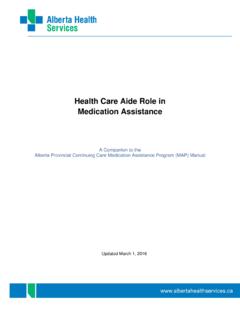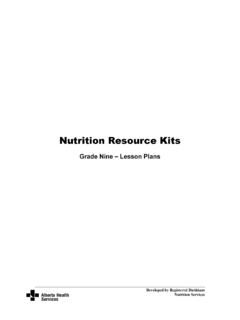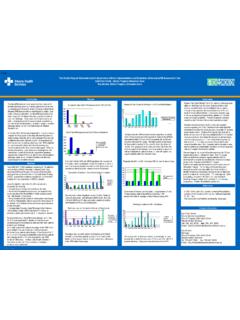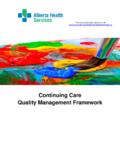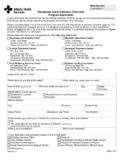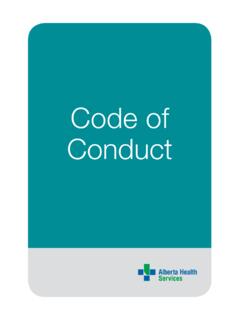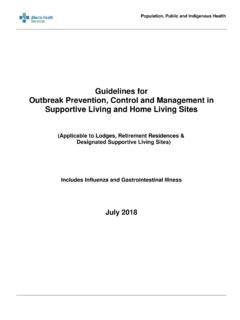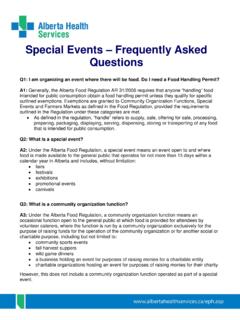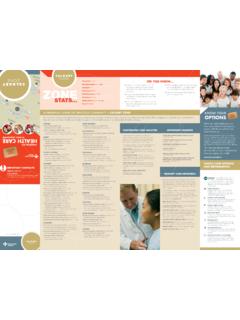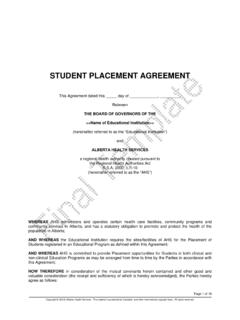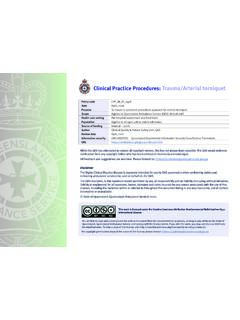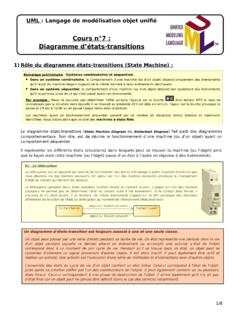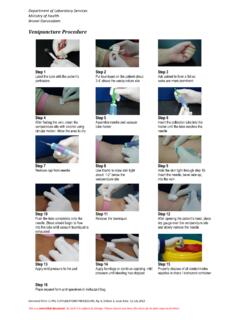Transcription of Performing Blood Collections Using a Butterfly Needle
1 AHS Laboratory Services Edmonton Zone Preanalytics and Specimen Handling Performing Blood Collections Using a Butterfly Needle RPACSS00012. Effective Date: 24 August 2018 Version: Performing Blood Collections Using a Butterfly Needle This document is applicable at site(s): All Sites Purpose This procedure provides instructions on how to collect a Blood sample Using a Butterfly Needle as well as when a Blood collection requiring a Butterfly Needle should be considered. Background The vacutainer/straight Needle method for Performing Blood Collections is the method of choice and should always be considered first. Phlebotomists should not become dependent on the use of butterflies for patients with veins that can be accessed with a straight Needle . The tubing associated with the Butterfly Needle is more prone to clotting than the use of a straight Needle .
2 There is an increased risk of needlestick injury when a Butterfly Needle is used. Butterfly needles (winged sets) are to be used only in special circumstances for Blood collection. These include: Very small and fragile veins, hands, feet, neonates Patient's with tremors or uncontrolled movements Blood Cultures PAXgene tube Collections Haemophiliac patients Venous Blood gases Patients who cannot physically or easily change the position of their arms When 10 or more tubes are to be collected at one time Policy All phlebotomists will wash their hands Using Alcohol Based Hand Sanitizer (ABHS) or soap &. water between each patient. All phlebotomists will wear gloves when Performing venipuncture or dealing with bodily fluids. A phlebotomist will never re-cap or reuse a Needle Materials Reagents Supplies Alcohol Prep Pads / Laboratory Requisition / Trip Doctor to Draw Cards 70% Isopropyl List / Log Sheet Biohazard Bags Alcohol Nitrile Gloves Butterfly Needles; various Alcohol Based Hand Vacutainers / Tubes; various gauges (See Additional Sanitizer (ABHS) types as per tests ordered Information).
3 Microsan Sharps Disposal Container LIS or Hospital labels (if Disposable Vacutainer available). Holders Gauze/Cotton Balls Tape and/or Band-Aids Latex Free Tourniquet Safety The controls required to protect laboratory personnel from the hazards present in this procedure or task are listed in the Hazard Assessment. All laboratory personnel Performing this procedure or task must be trained on when and how to use any required controls. Printed copies are UNCONTROLLED unless signed by an authorized lab personnel below. (Authorized individuals are: lab personnel designated in their zone/program or provincial role to produce print copies). Controlled Copy: Date Printed: Initials: Page 1 of 10. AHS Laboratory Services Edmonton Zone Preanalytics and Specimen Handling Performing Blood Collections Using a Butterfly Needle RPACSS00012. Effective Date: 24 August 2018 Version: Procedure NOTE: a patient has the right to refuse a Blood collection.
4 See Handling Patient Blood Collection Refusals. Step Detail Information 1. Identify the patient: If Then Hand hygiene may Inpatient: See Identifying Inpatients on Patient Care need to be performed if Units. there will be direct See Identifying Inpatients and Collecting contact with the patient Specimens for Blood Bank on Patient Care / patient environment. Units if the collection is for a pre-transfusion See Hand Hygiene test (XM, TYSH, Draw & Hold). Guideline for Outpatient: See Identifying Outpatients in Outpatient Laboratory Personnel Laboratory or Collection Site. within Patient Care See Identifying Outpatients and Collecting Settings. Specimens for Blood Bank in the Outpatient Laboratory or Collection Site if the collection is for a pre-transfusion test (XM, TYSH, Draw & Hold). 2. Perform Hand ) Hand hygiene must be performed. The Hand hygiene Hygiene: ) Wash hands with soap and water or ABHS.
5 Opportunity for before patient / patient NOTE: environment contact Hand hygiene must be performed if there will be direct (Moment 1) can be contact with the patient/patient environment. combined with before a Hand Hygiene must be performed when accessing clean / aseptic clean supplies. (Moment 2). Moment 1. & 2 are combined. 3. Put on a new pair of ) Gloves must not be reused between patients. gloves: 4. Assemble collection ) See Supplies in Materials list. materials at the patient's bedside /. chair side: 5. Insert the Needle ) Open the Butterfly Needle package and remove the set. into the vacutainer NOTE: the sheathed end of the Needle is exposed. holder: ) Grasp the set by the plastic portion closest to the sheathed end (furthest away from the Butterfly wings'). when handling and inserting into the vacutainer holder. ) Screw the sheathed end of the Needle in a right twisting motion onto the vacutainer holder.
6 6. Prepare tubes: ) Determine the order of draw for the Blood collection See Order of Draw tubes. Printed copies are UNCONTROLLED unless signed by an authorized lab personnel below. (Authorized individuals are: lab personnel designated in their zone/program or provincial role to produce print copies). Controlled Copy: Date Printed: Initials: Page 2 of 10. AHS Laboratory Services Edmonton Zone Preanalytics and Specimen Handling Performing Blood Collections Using a Butterfly Needle RPACSS00012. Effective Date: 24 August 2018 Version: Step Detail Information 7. Place the first tube ) Be careful to NOT puncture the cap of the tube as the to be drawn loosely tube vacuum will be lost. in the vacutainer If Then . holder: The first tube to A discard tube must be drawn before be drawn is a filling the tube for analysis. A minimum light blue (Na volume of 1 mL is required.
7 Citrate) or black NOTE: the discard tube must be the top (Excyte) same type as the tube to be collected tube: for analysis ( the same additive). 8. Position the patient: ) Ensure the patient is either in a sitting position or is lying Never draw Blood from down. a patient who is ) Ensure no food, liquid, chewing gum, or other objects standing. ( thermometers) are in the patient's mouth at the time Have patient remove of collection, except for essential medical treatment( all items from mouth newborns receiving oral fluids, patients on ventilators). (Note: this is to prevent a choking incident in the event of an adverse reaction during the collection. 9. Ask the patient to ) The patient should extend their arm in a manner which extend their arm: creates a straight line from the shoulder to the wrist. ) The patient's hand should be facing upwards, exposing the inside ante-cubital fossa region of the arm.
8 10. Apply the tourniquet: )The tourniquet should be applied approximately 7-10 If a tourniquet has centimeters away from the intended puncture site. been in place for longer NOTE: stretch the tourniquet before applying to prevent than one minute before pinching the skin. accessing the vein, it )Tie the tourniquet tight enough that the veins in the arm must be released and are distended, but not too tight that it causes the patient reapplied after three discomfort or to cause purple/blue discoloration to the minutes, before the patient's arm. venipuncture is performed. 11. Ask the patient to NOTE: instruct the patient to NOT pump their fist. Pumping of the fist can close their hand and lead to make a fist: hemoconcentration and erroneous test results. Printed copies are UNCONTROLLED unless signed by an authorized lab personnel below. (Authorized individuals are: lab personnel designated in their zone/program or provincial role to produce print copies).
9 Controlled Copy: Date Printed: Initials: Page 3 of 10. AHS Laboratory Services Edmonton Zone Preanalytics and Specimen Handling Performing Blood Collections Using a Butterfly Needle RPACSS00012. Effective Date: 24 August 2018 Version: Step Detail Information 12. Choose ) Using your fingertips, feel for the vein. See Appendix A for venipuncture site: )Feel for the median cubital or median cephalic veins diagram. located in the ante-cubital fossa region of the upper arm. NOTE: The order of choice for anatomical site for venipuncture is the: Arm Hand Foot only as a last resort. Inform patient's nurse that a foot collection will be attempted. If Then . If a patient is receiving a Delay the collection (if Blood transfusion and a possible) 15-60 minutes post Blood sample needs to be transfusion (the longer the collected: better) and obtain the sample from an alternate site ( opposite arm).
10 A sample must be collected Obtain the sample from an during transfusion: alternate site. NOTE: for a more accurate hemoglobin, obtain the Blood sample 1 hour post transfusion. A 15 minute post transfusion sample is adequate for a platelet count. What to Locate a vein that is palpable / has some look for: bounce to it. Note the location of the vein. Note the direction in which the vein is running. What Extensive scarring. areas to Bruising avoid: Hematomas Fistulas Superficial surface veins. Underside of wrists. IV site: see Collecting Blood from Patients with an IV IV Cannula. Side of body where mastectomy was performed: See Blood Collections on Mastectomy Patients. If a vein is Rotate the wrist. difficult to Palpate site with a finger wetted with alcohol find: (reduces friction). Massage arm from wrist to elbow. Tap site sharply with index and second finger 2-3 times.
